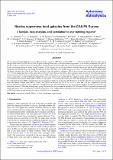Nearby supernova host galaxies from the CALIFA Survey : I. Sample, data analysis, and correlation to star-forming regions
Abstract
We use optical integral field spectroscopy (IFS) of nearby supernova (SN) host galaxies (0.005 < z < 0.03) provided by the Calar Alto Legacy Integral Field Area (CALIFA) Survey with the goal of finding correlations in the environmental parameters at the location of different SN types. In this first study of a series we focus on the properties related with star formation (SF). We recover the sequence in association of different SN types to the star-forming regions by using several indicators of the ongoing and recent SF related to both the ionized gas and the stellar populations. While the total ongoing SF is on average the same for the three SN types, SNe Ibc/IIb tend to occur closer to star-forming regions and in higher SF density locations than SNe II and SNe Ia; the latter shows the weakest correlation. SNe Ia host galaxies have masses that are on average ∼0.3−0.8 dex higher than those of the core collapse (CC) SNe hosts because the SNe Ia hosts contain a larger fraction of old stellar populations. Using the recent SN Ia delay-time distribution and the SFHs of the galaxies, we show that the SN Ia hosts in our sample are expected to produce twice as many SNe Ia as the CC SN hosts. Since both types occur in hosts with a similar SF rate and hence similar CC SN rate, this can explain the mass difference between the SN Ia and CC SN hosts, and reinforces the finding that at least part of the SNe Ia originate from very old progenitors. By comparing the mean SFH of the eight least massive galaxies with that of the massive SF SN Ia hosts, we find that the low-mass galaxies formed their stars during a longer time (0.65%, 24.46%, and 74.89% in the intervals 0–0.42 Gyr, 0.42–2.4 Gyr, and >2.4 Gyr, respectively) than the massive SN Ia hosts (0.04%, 2.01%, and 97.95% in these intervals). We estimate that the low-mass galaxies produce ten times fewer SNe Ia and three times fewer CC SNe than the high-mass group. Therefore the ratio between the number of CC SNe and SNe Ia is expected to increase with decreasing galaxy mass. CC SNe tend to explode at positions with younger stellar populations than the galaxy average, but the galaxy properties at SNe Ia locations are one average the same as the global galaxy properties.
Citation
Galbany , L , Stanishev , V , Mourão , A M , Rodrigues , M , Flores , H , García-Benito , R , Mast , D , Mendoza , M A , Sánchez , S F , Badenes , C , Barrera-Ballesteros , J , Bland-Hawthorn , J , Falcón-Barroso , J , García-Lorenzo , B , Gomes , J M , González Delgado , R M , Kehrig , C , Lyubenova , M , López-Sánchez , A R , De Lorenzo-Caceres Rodriguez , A , Marino , R A , Meidt , S , Mollá , M , Papaderos , P , Pérez-Torres , M A , Rosales-Ortega , F F & Van De Ven , G 2014 , ' Nearby supernova host galaxies from the CALIFA Survey : I. Sample, data analysis, and correlation to star-forming regions ' , Astronomy & Astrophysics , vol. 572 , A38 . https://doi.org/10.1051/0004-6361/201424717
Publication
Astronomy & Astrophysics
Status
Peer reviewed
ISSN
0004-6361Type
Journal article
Collections
Items in the St Andrews Research Repository are protected by copyright, with all rights reserved, unless otherwise indicated.

